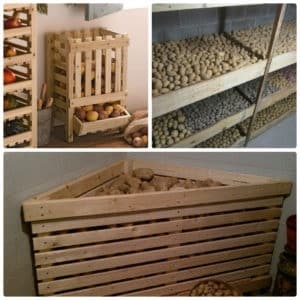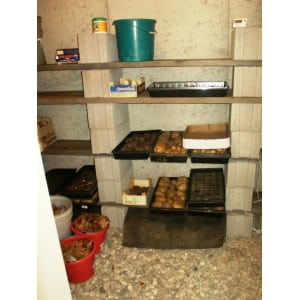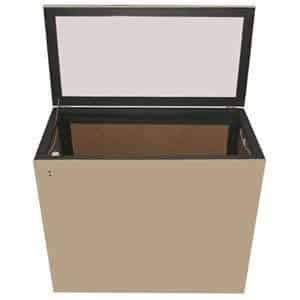Features of storing potatoes in a garage without a cellar
Potatoes are an integral part of the diet of most people in our country. It is not for nothing that people call this vegetable “second bread”. Gardeners who grow potatoes usually do this in large quantities, with a reserve until the next harvest. Therefore, the issue of storing potatoes is always relevant.
A garage can be adapted for these needs, but in order for the vegetable to retain its freshness and excellent taste longer, the room must be properly prepared. We'll tell you how to store potatoes in a cold and warm garage in this article.
Preparing potatoes for storage
In order for potatoes to retain their fresh and appetizing appearance until spring, it is important to properly prepare them for wintering:
- Dry the tubers outdoors or in a well-ventilated area if it rains on the day of harvest. In this case, you should avoid exposing the vegetable to direct sunlight.
- Sort through the crop, remove all “substandard” - damaged specimens.
- Sort potatoes by size and purpose (seed material, potatoes for food).
Ideal tubers set aside for storage should be clean and dry, with intact, tight skins. If there are shoots, they need to be removed. If there is damage: cuts, wormholes, rot or mold, green areas, then such specimens are disposed of.
Even if at first glance the wound on the tuber is very small, over time it can cause infection of all the potatoes stored nearby.
Reference. The keeping quality of the root crop also depends on the variety. Early and mid-season varieties are stored for no more than 3-6 months. For long-term storage of potatoes in the garage in winter, it is better to choose late varieties.
Storage in a garage without a cellar and with a cellar
The main problem with crop storage is rot. Spoiled vegetables are not only unsuitable for consumption, but are also dangerous because they infect all stored products with infection, reducing the gardener’s efforts to zero.
The main reasons for potato rotting are:
- high humidity;
- cold;
- heat.
Humid air is a favorable environment for the development of pathogenic fungi and mold. To avoid this, you should maintain air humidity no higher than 75-80% and sprinkle the bottom of the storage container or the floor of the room with drainage material - for example, crushed stone or pebbles.
If the temperature is too low, the crop will freeze, starch is converted into sugar, and the vegetable acquires a characteristic sweet taste. If the temperature is higher than the recommended +2°C...+4°C, the potatoes will sprout and take root, which will significantly worsen their taste and keeping quality.
Important! Light is contraindicated for potato fruits, because under its influence, solanine is formed in tubers - a substance harmful to the human body.
What is the difference
Garages with a cellar are more preferable because... Fully recessed storage facilities are optimal for storing crops. This is due to the constant temperature in the cellar, practically independent of weather fluctuations and changing seasons.
In addition, direct sunlight does not enter the cellar, therefore, poisonous solanine is not produced in the tubers. On the other hand, in the absence of a ventilation system in the cellar, air humidity is often increased.
Not every garage is equipped with a basement, but if space allows, storing potatoes in a garage without a cellar is also possible.But you should think in advance about the possibility of regulating the temperature in the room in order to prevent the tubers from freezing in the garage in winter.
How to prepare a garage for storage
Before sending potatoes for storage, you need to treat the room. In addition to the usual cleaning of litter and dirt, it involves the use of lime whitewash:
- 150 g table salt;
- 2 kg of slaked lime;
- 1 kg of copper sulfate;
- 10 liters of water.
A pre-prepared mixture is used to whiten the walls of the cellar or the area inside the garage reserved for harvest storage.
Reference. Whitewashing will prevent the possible spread of mold.
The second important point is the ventilation system. It needs to be cleaned and the operation of the exhaust system checked. Before directly planting potatoes, the room must be thoroughly ventilated.
Arranging a basement in a garage
Not everyone knows how to properly store potatoes in the basement or garage. In order for it to be suitable for storing vegetables, it must be properly equipped:
- If the soil moisture is low, the walls can be built of brick, but for high humidity, concrete walls with waterproofing are more suitable.
- Ideally, the floor should consist of three layers: crushed stone, bitumen and concrete mixture. This will provide the necessary drainage and air capacity.
- For disinfection purposes, the walls are covered with lime.
- To prevent condensation from settling on the ceiling, the upper plane should be tilted towards the hood.
- Because Bright light has a detrimental effect on the keeping quality of potatoes; it is better to give preference to low-voltage lighting.
When equipping a cellar in a garage, you need to know where the groundwater passes - to avoid moisture seepage, the bottom of the storage facility is located no closer than 2 m from them.
Arranging a garage without a basement
If the garage does not have a basement, this is not a reason to be upset. By properly organizing the space for storing crops, you can use almost any free space for these purposes:
- The garage should provide the possibility of thermoregulation, because... severe frosts or, on the contrary, elevated air temperatures can ruin the harvest. For this purpose, thermometers and heaters are installed.
- The tubers are covered with breathable material (straw, burlap, etc.). On the one hand, this will protect vegetables from light, on the other hand, it will serve as additional heat and moisture insulation.
- If possible, potato trays should be raised above floor level. As a last resort, make a thick base of straw, newspaper, earth and heat-insulating material.
Like the cellar, the garage must be cleaned, ventilated and dried before use, and then treated with a disinfectant.
How and in what to store
The container for storing potatoes plays no less significant role than the room. It is better if these are solid wooden boxes, allowing air to circulate freely between the rows of tubers.
In unheated garages and on balconies, thermal boxes with a layer of thermal insulation are an excellent option for storing vegetables.
Finally, you can store potatoes the old-fashioned way - in piles, as well as in bags and nets.
Preparing a container for storage in the garage
All storage equipment (pallets, boxes, bags and nets) are pre-dried and disinfected.
There are several ways to do this:
- treatment with a solution of potassium permanganate (potassium permanganate);
- “roasting” in the sun;
- treatment with a mixture of lime and copper sulfate (100 g per 10 l).
If straw is used as a covering material or substrate for potatoes, it must also be disinfected. For example, douse it with steam or boiling water and then dry it.
Boxes
This is one of the most convenient and aesthetic ways to organize potato storage.
 Firstly, such containers allow you to keep tubers of different varieties and sizes separately. Secondly, if necessary, vertical stacking of boxes is possible, which significantly saves space.
Firstly, such containers allow you to keep tubers of different varieties and sizes separately. Secondly, if necessary, vertical stacking of boxes is possible, which significantly saves space.
The box is made of wood, with a distance between slats of 2-4 cm.
For better ventilation, the boxes are placed at a distance of at least 30 cm from the wall and 20 cm from the floor, not too close to each other (about 10 cm).
Reference. In addition to wooden ones, manufacturers offer perforated plastic containers. You need to treat them with care and check that there are air holes not only on the lid of the container, but throughout its entire area.
Burt
This is the most common and economical storage option, because... it is easy to implement and does not require the purchase of special equipment.
A pile is a long mound of potatoes. To prevent collapse, the rows are fenced with boards, and for insulation they are covered with a layer of straw (60 cm), earth (50-70 cm) and heat-insulating material. For ventilation, a vertical pipe is installed in the center of the embankment. For drainage, grooves are dug around the collar.
This method is good as temporary storage in naturally ventilated areas. It is not suitable for longer storage because:
- the area occupied is too large,
- it is difficult to regulate the temperature in the center of the potato mound,
- with insufficient ventilation, rotting, infection with fungus and other infections is possible;
- the design is inconvenient to use: it is difficult to remove the potatoes and sort them out to remove the sprouts that have formed.
When creating a pile, you need to remember that the height of the embankment should not exceed 1 m, otherwise the root crops will be poorly ventilated and will soon rot.
Thermal box
Thermal boxes, or thermal cabinets, are equipped in such a way that, having their own ventilation, they maintain a positive temperature inside, i.e. protect the crop from external influences.
Typically, a heating cabinet is made as a metal box with an insulated body. It also has a tray and legs. There is a built-in thermostat inside that maintains constant air circulation within +2°C...+7°C.
Disadvantages of this method:
- limited volume (the largest industrial ovens are made with a volume of 360 liters);
- high cost (from 6.5 to 11.5 thousand rubles);
- connecting to the power supply during the cold season - therefore, free sockets are required and energy consumption increases.
You can make something similar to a heating cabinet yourself: place two wooden boxes of different sizes inside each other, laying a heat-insulating layer between them. Craftsmen line the bottom of a smaller box with underfloor heating film and synchronize it with a thermostat on the outside of the structure.
Reference. Instead of a heating cabinet, you can use a used refrigerator. It doesn't even need to be connected to power, because... The body itself is already thermally insulated.
Nets or bags
Nets and bags as a way to store potatoes do not lose their relevance, because... it's cheap and convenient.
To avoid contact with moisture and cold floors, nets and bags are placed on pallets and insulated with straw or hay on top.
Natural burlap and mesh with large holes do not interfere with the natural and constant circulation of fresh air between the tubers, which is important for the prevention of various diseases. In addition, the bags are convenient to move if necessary.
Cellar
You should not store potatoes in bulk in the cellar - the vegetable may suffocate due to insufficient ventilation. Therefore, special containers - bins - are organized inside the basement for potatoes. These can also be wooden boxes with gaps between the slats.
When arranging the boxes, take into account that air should circulate freely between the containers, therefore:
- the maximum height should not exceed 60 cm to the ceiling of the cellar;
- The boxes are raised above the floor by 15-20 cm;
- move 30 cm away from the wall;
- Leave 10 cm between boxes.
Alternative storage methods
In addition to the garage, you can use a garden plot, balcony or loggia in a city apartment to store potatoes.
Our grandparents used special pits to preserve the harvest. You can arrange it now on your personal plot. For this:
- dig a hole at least 1.5 m deep;
- the bottom and walls are lined with wooden boards, straw is laid on top;
- cover the tubers with a layer of about 1 m (50 cm should remain to the edge);
- The potatoes are covered with straw, boards, and then covered with earth.
If it is inconvenient to go to the dacha for the next portion of potatoes, you can store them right on your balcony. A thermal box, either purchased or homemade, is ideal for this purpose. If the box is made independently, it is insulated with polystyrene foam, cardboard, rags or sawdust, and unnecessary warm clothes are placed on top of the vegetables. They must be clean and made from natural materials so that the tubers can breathe.
On an insulated loggia, it is enough to install suitable-sized boxes made of wood or plastic and periodically sort through the potatoes for rotten specimens to remove sprouts.
Tips and tricks
Experienced summer residents share useful information on online forums - we’ll share with you some nuances:
- Elevated temperatures are no less harmful when storing potatoes than frosts. Heat coupled with dry air causes dried out and flabby vegetables.
- Storing different vegetables in one tray is not the best idea. But the proximity of beets and potatoes will bring a positive result, because... the beets will absorb excess moisture, improving the keeping quality of potato tubers.
Read also:
Conclusion
Knowing the simple storage rules, you can enjoy dishes from potatoes grown with your own hands all winter and spring and save the seed material for the next summer season without loss. Have a rich and ripe harvest!